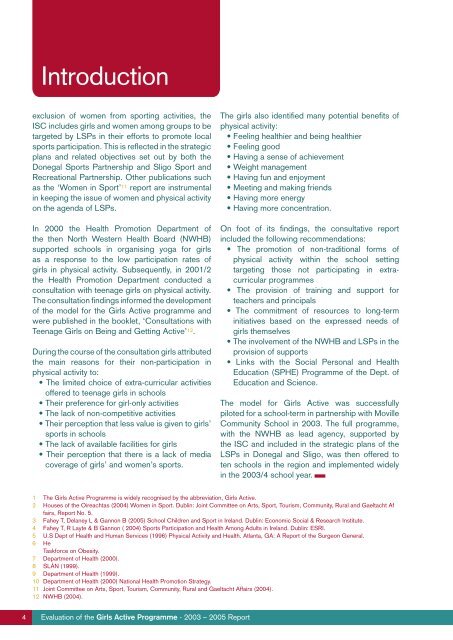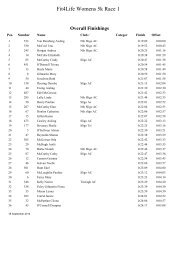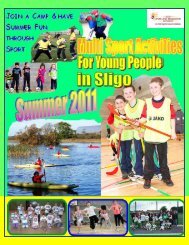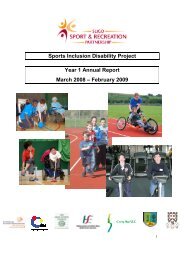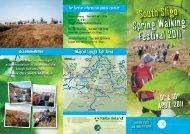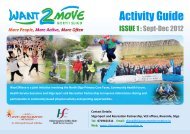Girls Active Programme - Sligo Sport and Recreation Partnership
Girls Active Programme - Sligo Sport and Recreation Partnership
Girls Active Programme - Sligo Sport and Recreation Partnership
Create successful ePaper yourself
Turn your PDF publications into a flip-book with our unique Google optimized e-Paper software.
Introduction<br />
exclusion of women from sporting activities, the<br />
ISC includes girls <strong>and</strong> women among groups to be<br />
targeted by LSPs in their efforts to promote local<br />
sports participation. This is reflected in the strategic<br />
plans <strong>and</strong> related objectives set out by both the<br />
Donegal <strong>Sport</strong>s <strong>Partnership</strong> <strong>and</strong> <strong>Sligo</strong> <strong>Sport</strong> <strong>and</strong><br />
<strong>Recreation</strong>al <strong>Partnership</strong>. Other publications such<br />
as the ‘Women in <strong>Sport</strong>’ 11 report are instrumental<br />
in keeping the issue of women <strong>and</strong> physical activity<br />
on the agenda of LSPs.<br />
In 2000 the Health Promotion Department of<br />
the then North Western Health Board (NWHB)<br />
supported schools in organising yoga for girls<br />
as a response to the low participation rates of<br />
girls in physical activity. Subsequently, in 2001/2<br />
the Health Promotion Department conducted a<br />
consultation with teenage girls on physical activity.<br />
The consultation findings informed the development<br />
of the model for the <strong>Girls</strong> <strong>Active</strong> programme <strong>and</strong><br />
were published in the booklet, ‘Consultations with<br />
Teenage <strong>Girls</strong> on Being <strong>and</strong> Getting <strong>Active</strong>’ 12 .<br />
During the course of the consultation girls attributed<br />
the main reasons for their non-participation in<br />
physical activity to:<br />
• The limited choice of extra-curricular activities<br />
offered to teenage girls in schools<br />
• Their preference for girl-only activities<br />
• The lack of non-competitive activities<br />
• Their perception that less value is given to girls’<br />
sports in schools<br />
• The lack of available facilities for girls<br />
• Their perception that there is a lack of media<br />
coverage of girls’ <strong>and</strong> women’s sports.<br />
The girls also identified many potential benefits of<br />
physical activity:<br />
• Feeling healthier <strong>and</strong> being healthier<br />
• Feeling good<br />
• Having a sense of achievement<br />
• Weight management<br />
• Having fun <strong>and</strong> enjoyment<br />
• Meeting <strong>and</strong> making friends<br />
• Having more energy<br />
• Having more concentration.<br />
On foot of its findings, the consultative report<br />
included the following recommendations:<br />
• The promotion of non-traditional forms of<br />
physical activity within the school setting<br />
targeting those not participating in extracurricular<br />
programmes<br />
• The provision of training <strong>and</strong> support for<br />
teachers <strong>and</strong> principals<br />
• The commitment of resources to long-term<br />
initiatives based on the expressed needs of<br />
girls themselves<br />
• The involvement of the NWHB <strong>and</strong> LSPs in the<br />
provision of supports<br />
• Links with the Social Personal <strong>and</strong> Health<br />
Education (SPHE) <strong>Programme</strong> of the Dept. of<br />
Education <strong>and</strong> Science.<br />
The model for <strong>Girls</strong> <strong>Active</strong> was successfully<br />
piloted for a school-term in partnership with Moville<br />
Community School in 2003. The full programme,<br />
with the NWHB as lead agency, supported by<br />
the ISC <strong>and</strong> included in the strategic plans of the<br />
LSPs in Donegal <strong>and</strong> <strong>Sligo</strong>, was then offered to<br />
ten schools in the region <strong>and</strong> implemented widely<br />
in the 2003/4 school year.<br />
1 The <strong>Girls</strong> <strong>Active</strong> <strong>Programme</strong> is widely recognised by the abbreviation, <strong>Girls</strong> <strong>Active</strong>.<br />
2 Houses of the Oireachtas (2004) Women in <strong>Sport</strong>. Dublin: Joint Committee on Arts, <strong>Sport</strong>, Tourism, Community, Rural <strong>and</strong> Gaeltacht Af<br />
fairs, Report No. 5.<br />
3 Fahey T, Delaney L & Gannon B (2005) School Children <strong>and</strong> <strong>Sport</strong> in Irel<strong>and</strong>. Dublin: Economic Social & Research Institute.<br />
4 Fahey T, R Layte & B Gannon ( 2004) <strong>Sport</strong>s Participation <strong>and</strong> Health Among Adults in Irel<strong>and</strong>. Dublin: ESRI.<br />
5 U.S Dept of Health <strong>and</strong> Human Services (1996) Physical Activity <strong>and</strong> Health. Atlanta, GA: A Report of the Surgeon General.<br />
6 He<br />
Taskforce on Obesity.<br />
7 Department of Health (2000).<br />
8 SLÁN (1999).<br />
9 Department of Health (1999).<br />
10 Department of Health (2000) National Health Promotion Strategy.<br />
11 Joint Committee on Arts, <strong>Sport</strong>, Tourism, Community, Rural <strong>and</strong> Gaeltacht Affairs (2004).<br />
12 NWHB (2004).<br />
4<br />
Evaluation of the <strong>Girls</strong> <strong>Active</strong> <strong>Programme</strong> - 2003 – 2005 Report


